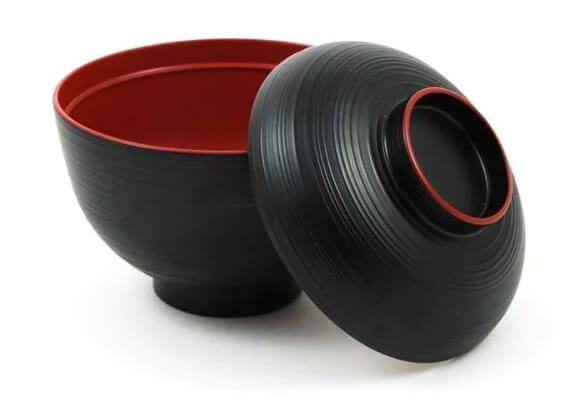
Miso soup is glorious on so many levels. It’s a filling, and fulfilling, little meal in one. Easy to prepare, easy to consume, and rather satiating.
If you’ve never sampled the delights of this simple dish then… well, you’re an idiot! But never fear, you can cure your idiocy post-haste by rushing to your nearest store to buy some of the stuff.
But if you need convincing, this look into the history of miso soup will (probably) help sway your opinion.
What’s Miso Soup?
Basically, miso soup (misoshiru—味噌汁) is a nutrition-rich fermented Japanese soup. It’s long entered into the nation’s foodstuff traditions and consists of dashi stock that’s softened into a miso paste.
The soup can be consumed by itself, but many restaurants jazz it up by adding in tofu chunks, spring onions, and wakame (kelp). Plus, it has an artistic quality—swirling away in the murky depths of paste.
Miso soup is typically served as a starter. This seems to be the case for the various sushi restaurants we’ve visited.
And it’s a fine appetiser ahead of the main meal of sushi ahead.
What can we say? It’s incredible stuff, with a pungent earthy quality that packs a punch and also provides many, many health benefits.
It’s rich in nutrients, including vitamin K, manganese, zinc, protein, and calcium. Truly, the dish is the stuff of wonder.
The History of Miso Soup
Japanese food culture places miso soup amongst its various soup dishes, most of which are served with rice.
Along with misoshiru, it also goes by the name of omiotsuke (御味御付).
Naturally, miso soup didn’t arrive on the scene readily packed and available for purchase from your nearest supermarket. It developed steadily over Japanese eras. Let’s dig into that, eh?
Miso Paste and the Heian Period
Unsurprisingly, miso has been part of Japanese life for some time. Estimates date it back to 1,300 years. That dates back to the Heian period (平安時代—Heian jidai), which was the essentially the last era of classical Japan. That ran from 794-1185.
It was during that era the Japanese writing system introduced the symbol for miso. Back then it was just a paste that was spread onto foods, or eaten directly.
And it immediately reached an impressive status, being used to pay the salaries for the elite in society. It was also handed over as a present.
The Kamakura Period Brings to the World Miso Soup
Miso soup emerged during the Kamakura period. (1185-1333).
Suribachi mortars were introduced to Japanese society by Chinese monks, which led to the easy grinding of grains. This was epochal, bringing in a new era for Japan’s mealtime etiquette.
The arrival of miso soup shaped the Japanese dining routine of ichiju sansai (一汁三菜), which translates as:
“One soup, three dishes.”
And if you’ve eaten at a Japanese restaurant, that typically means:
- A soup starter
- Rice
- One side dish (sometimes two)
- One main dish (sashimi, sushi, or a grilled dish)
- Pickled ginger
It’s all about classical Japanese minimalism—being frugal. Samurai would chow down on it all, helping to keep them energised and nourished.
Muromachi and Sengoku Periods
Heading into the Age of Discovery, Medieval times, and Renaissance, Nippon went into overdrive with the development of miso cooking.
The paste is actually used in all sorts of dishes.
With agricultural practises in the Sengoku period (1467-1615) advancing, farmers began mass producing unique miso types.
It’s an era where miso cooking, amongst the elite and working-class scumbags, really became the norm. Truly, miso had cemented itself as a Japanese powerhouse tradition.
Sengoku and Edo Period
Sakoku (鎖国) means “chained country” and was a direct foreign policy from the Japanese Tokugawa government. It lasted for some 250 years, right up until 1868.
The Edo period ran from 1603-1867 and produced a lot of great art, such as Edo blocks and The Great Wave Off Kanagawa.
Miso became enormously popular and it was difficult for Japan to keep up with public demand. Miso shops sprung up and restaurants dedicated to the paste became a big deal in society.
Again, it just became part of Japanese life. Miso soup was for the Japanese kind of like what Marmite is to the UK. Cheap, readily accessible, and nutritious.
Shōwa Period and Modernity
The Shōwa period (1926-1989) was all about Emperor Shōwa (1926-1989, obviously). However, after the events of WWII the emperor’s status as a demigod ended.
Japan now has a much more open and liberal democracy.
With the arrival of refrigerators, miso could be stored in containers for much longer. This allowed 20th century Japan to easily meet demand.
And with the widespread emergence of Japanese culture in the western world after WWII, miso soup gained global popularity.
Its spread has been heroic!
From humble begins in the Heian period to what we all have access to now. It’s the stuff of dreams. But… you need to get your presentation of it just right.
Lacquer Bowls and Miso Soup Presentation
Over on our other blog, Moonshake Books, we covered Tanizaki’s In Praise of Shadows (1933). The essay is all about hunting down those moments of psychological well-being.
Tanizaki argues the importance of a lacquerware bowl with the soup.
“There is a beauty in that moment between removing the lid and lifting the bowl to the mouth when one gazes at the still, silent liquid in the dark depths of the bowl, its colour hardly differing from that of the bowl itself. What lies within the darkness one cannot distinguish, but the palm senses the gentle movements of the liquid, vapour rises from within forming droplets on the rim, and the fragrance carried upon the vapour brings a delicate anticipation. What a world of difference there is between this moment and the moment when soup is served Western style, in a pale, shallow bowl. A moment of mystery, it might almost be called, a moment of trance.”
It’s thanks to Tanizaki we went off and hunted down a lacquer bowl for our (usually daily) intake of miso soup. One of these.

Typically, they have that distinctive black outer casing with a red inner lining. With miso soup within, you can see that earthy, dark, shadowy swirling.
The soup billows about the place in the bowl. Therapeutic!
Not bad, eh? They’re super cheap to get and do add an extra element of authentic routine to the whole experience. Recommended!
How to Make Miso Soup
Making miso soup can be as easy or complex as you fancy. We usually just boil the water, let it cool for a bit in our lacquer miso soup bowl, and then add the paste.
Cover and leave for a while. Stir… and you’re good to go!
However, if you want something a bit more advanced you can fling in all sorts of fancy ingredients. Stuff you’ll need includes:
Miso,
Tofu,
Dashi,
Onion,
Spring onion,
Wakame.
Miso soup does work very well with small cubes of cooled tofu in there. And with the wakame chucked in and spring onions.
Remember, it’s best to add boiling water first and let it cool for a bit. Then add the miso soup, stir, and leave for a bit.
Yeah, that’s making us want to have a bowl of the stuff right now. Proper belting.

Now I’m hungry!
LikeLiked by 1 person
Make some miso soup!
LikeLike
Miso soup is great. I don’t get to try this out at home, but since I was a kid I’ve looked forward to going out to a Japanese place and I don’t think I’ve ever not started with miso.
LikeLiked by 1 person
Get yourself some miso soup for home! Seriously, adds some oomph into every day. As it is fantabulous.
LikeLiked by 1 person
Love Miso Soup. Thank you for the mouth watering details. 🥣
LikeLiked by 1 person
Bet you had some miso soup after this, eh?
LikeLiked by 1 person
I headed straight for Samurai. 🥢
LikeLiked by 1 person
I would advise against eating miso soup with a samurai sword.
LikeLiked by 1 person
Konichiwa 🏯it takes skill.
LikeLike
It takes skill… and a severed limb. I refuse to lose a second arm in the name of miso soup!
LikeLiked by 1 person
Miso is pretty good, are you sure?
LikeLike
All right, maybe my eyebrows. I don’t need those.
LikeLiked by 1 person
There you go! Miso goes great with no eyebrows 😎
LikeLike
I’m not putting eyebrow hair into miso soup, lady. That may be a big deal in America, but I ain’t not doin’ it.
LikeLiked by 1 person
Whateva, it’s quite yummy and adds fiber.
LikeLike
If I want fibre in my diet I’ll eat my BELT.
LikeLiked by 1 person
Really? Then what will you do for a belt?
LikeLike
Gain a huge amount of weight rapidly so I no longer need a belt.
LikeLiked by 1 person
Miso soup won’t get you there. You must eat haggis in abundance.
LikeLiked by 1 person
Yes, that’ll work on the weight gain front. Haggis is about as good for you as deep fried ice cream.
LikeLiked by 1 person
If only it tasted the same.
LikeLiked by 1 person